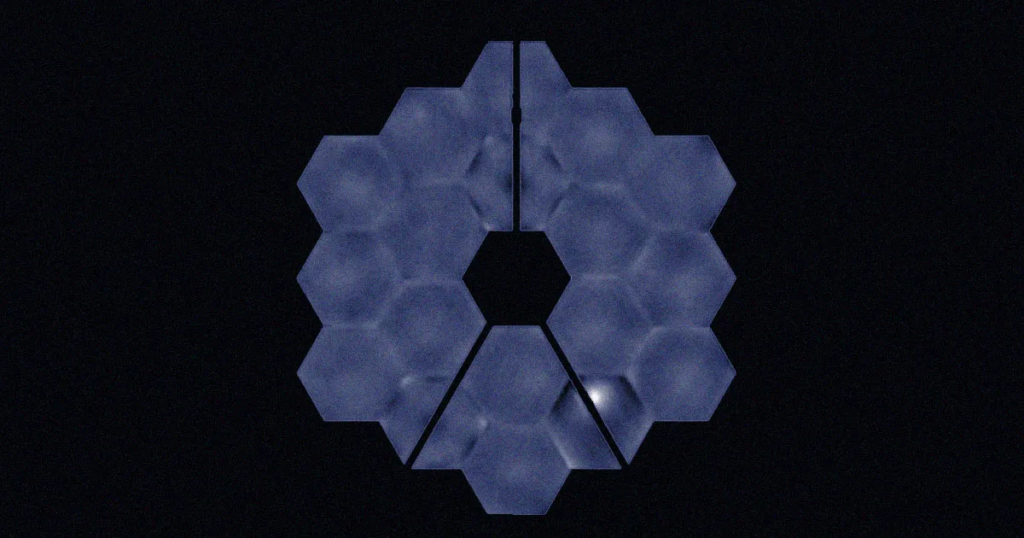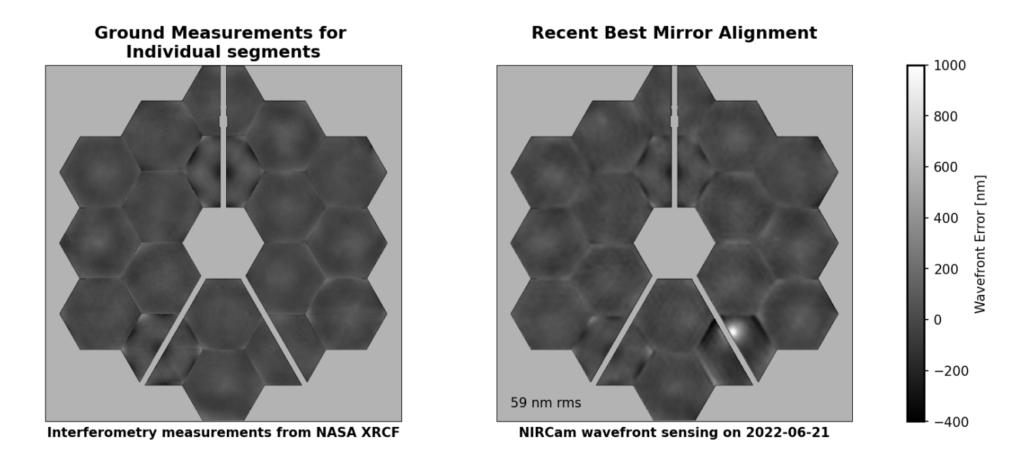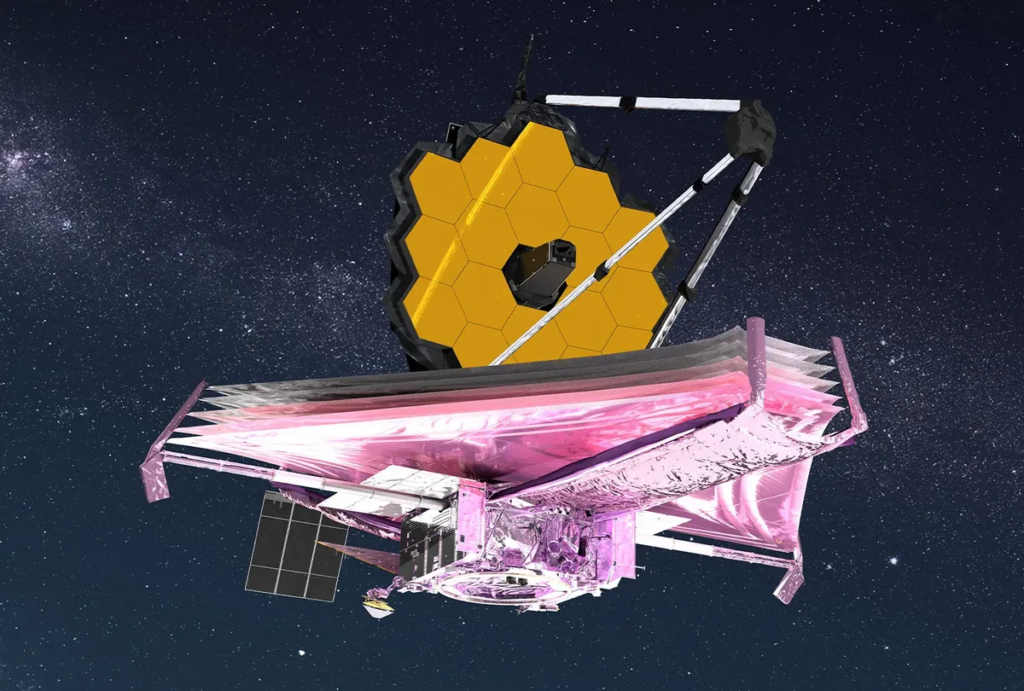
More Updates On Webb’s Recent Micrometeoroid Impact
Not long ago NASA provided an update on the James Webb Space Telescope in regards to a micrometeoroid impact. Specifically, the agency announced that between May 23rd and 25th, Webb sustained an impact on one of its 18 primary mirror segments. While the telescope is still performing at a level that exceeds all mission requirements, the agency continued to look into the impact.
We received more information on the impact only a few days ago thanks to an image. This image showed a selfie of the telescope and highlighted the impact on the bottom right mirror segment. The agency noted that the debris was more sizeable than pre launch modeling had accounted for. All of which is important for the future of Webb and its consistent science operations.
It’s important to point out the James Webb Space Telescope was built to withstand micrometeoroid impacts. Space is filled with flying debris and NASA knew the type of conditions Webb would be in for the duration of its science operations. Here I will go more in-depth into the recent image highlighting the damage, what it means for Webb’s future, and what to expect in the coming months.
New JWST Image

Recently, NASA released a report that not only included an updated image of the mirror and its damage but more information on the impact as well. Starting with the image, which was intended to highlight Wavefront Sensing Measurements showing the quality of achieved mirror alignment on orbit. Here you can see a before and after of Webb’s primary mirror segments. It’s clear when both images are side by side that the impact had quite the effect on the bottom right mirror segment. Additional images highlight the damage even more.
In the recent report, NASA highlights that inevitably, any spacecraft will encounter micrometeoroids. During commissioning, wavefront sensing recorded six localized surface deformations on the primary mirror that are attributed to impact by micrometeoroids. These occurred at a rate (roughly one per month) consistent with pre-launch expectations. Each micrometeoroid caused degradation in the wavefront of the impacted mirror segment, as measured during regular wavefront sensing. Some of the resulting wavefront degradation is correctable through regular wavefront control; some of it comprises high spatial frequency terms that cannot be corrected. There should also be a small effect on the telescope throughput, which is not yet measurable. Of the six micrometeoroid strikes detected thus far through wavefront sensing, five had negligible effects, contributing a combined total of < 1 nm to the overall wavefront error.
By contrast, the micrometeoroid which hit segment C3 in the period 22—24 May 2022 UT caused
significant uncorrectable change in the overall figure of that segment. However, the effect was small at the full telescope level because only a small portion of the telescope area was affected. After two subsequent realignment steps, the telescope was aligned to a minimum of 59 nm rms, which is about 5-10 nm rms above the previous best wavefront error rms values . It should be noted that the drifts and stability levels of the telescope mean that science observations will typically see telescope contribution between 60 nm rms (minimum) and 80 nm rms (where WF control will typically be performed).
The impact raised the wavefront error of segment C3 from 56 to 280 nm rms. Mirror commanding to
adjust segment position and curvature reduced this error to 178 nm rms. This, after dividing by area and
adding in quadrature to the other sources of WFE in the telescope, results in ~9 nm rms increase to the
total telescope wavefront error. The agency finished by highlighting it is not yet clear whether the May 2022 hit to segment C3 was a rare event (i.e. an unlucky early strike by a high kinetic energy micrometeoroid that statistically might occur only once in several years), or whether the telescope may be more susceptible to damage by micrometeoroids than pre-launch modeling predicted. The project team is conducting additional investigations into the micrometeoroid population, how impacts affect beryllium mirrors, and the efficacy and efficiency tradeoffs of potential mitigations such as pointing restrictions that would minimize time spent looking in the direction of orbital motion, which statistically has higher micrometeoroid rates and energies.
Webb & Impacts

Now that we know more about the impact and the exact effect it had on Webb, we can take a closer look at how NASA works to prevent and withstand the majority of these impacts. Micrometeoroid strikes are an unavoidable aspect of operating any spacecraft, which routinely sustain many impacts over the course of long and productive science missions in space. Back when the impact had just occurred, NASA’s initial assessments team found the telescope was still performing at a level that exceeds all mission requirements despite a marginally detectable effect in the data. Thorough analysis and measurements were ongoing. Impacts will continue to occur throughout the entirety of Webb’s lifetime in space; such events were anticipated when building and testing the mirror on the ground. After a successful launch, deployment, and telescope alignment, Webb’s beginning-of-life performance is still well above expectations, and the observatory is fully capable of performing the science it was designed to achieve.
Webb’s mirror was engineered to withstand bombardment from the micrometeoroid environment at its orbit around Sun-Earth L2 of dust-sized particles flying at extreme velocities. While the telescope was being built, engineers used a mixture of simulations and actual test impacts on mirror samples to get a clearer idea of how to fortify the observatory for operation in orbit. This most recent impact was larger than was modeled, and beyond what the team could have tested on the ground. “We always knew that Webb would have to weather the space environment, which includes harsh ultraviolet light and charged particles from the Sun, cosmic rays from exotic sources in the galaxy, and occasional strikes by micrometeoroids within our solar system,” said Paul Geithner, technical deputy project manager at NASA’s Goddard Space Flight Center in Greenbelt, Maryland. “We designed and built Webb with performance margin – optical, thermal, electrical, mechanical – to ensure it can perform its ambitious science mission even after many years in space.” For example, due to careful work by the launch site teams, Webb’s optics were kept cleaner than required while on the ground; their pristine cleanliness improves the overall reflectivity and throughput, thereby improving total sensitivity. This and other performance margins make Webb’s science capabilities robust to potential degradations over time.
Furthermore, Webb’s capability to sense and adjust mirror positions enables partial correction for the result of impacts. By adjusting the position of the affected segment, engineers can cancel out a portion of the distortion. This minimizes the effect of any impact, although not all of the degradation can be cancelled out this way. Engineers have already performed a first such adjustment for the recently affected segment C3, and additional planned mirror adjustments will continue to fine tune this correction. These steps will be repeated when needed in response to future events as part of the monitoring and maintenance of the telescope throughout the mission.
To protect Webb in orbit, flight teams can use protective maneuvers that intentionally turn the optics away from known meteor showers before they are set to occur. This most recent hit was not a result of a meteor shower and is currently considered an unavoidable chance event. As a result of this impact, a specialized team of engineers was formed to look at ways to mitigate the effects of further micrometeoroid hits of this scale. Over time, the team will collect invaluable data and work with micrometeoroid prediction experts at NASA’s Marshall Space Flight Center to be able to better predict how performance may change, bearing in mind that the telescope’s initial performance is better than expected. “With Webb’s mirrors exposed to space, we expected that occasional micrometeoroid impacts would gracefully degrade telescope performance over time,” said Lee Feinberg, Webb optical telescope element manager at NASA Goddard. “Since launch, we have had four smaller measurable micrometeoroid strikes that were consistent with expectations and this one more recently that is larger than our degradation predictions assumed. We will use this flight data to update our analysis of performance over time and also develop operational approaches to assure we maximize the imaging performance of Webb to the best extent possible for many years to come.”
Conclusion
The James Webb Space Telescope is continuing to make great progress. After releasing its first images Webb has proved to be a fully capable telescope that has begun consistent science operations. This being said, the recent impact according to NASA is hopefully very statically improbable. We will have to wait and see how it progresses and the impact it has on the space industry.
